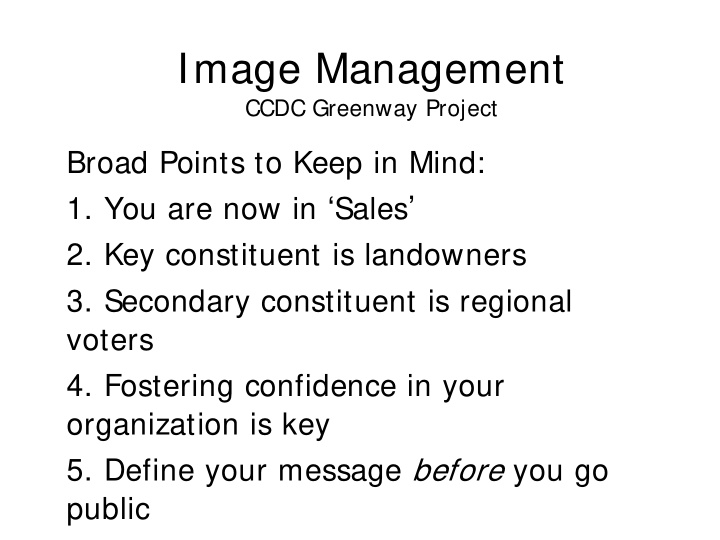



Image Management CCDC Greenway Project Broad Points to Keep in Mind: 1. You are now in ‘ Sales ’ 2. Key constituent is landowners 3. Secondary constituent is regional voters 4. Fostering confidence in your organization is key 5. Define your message before you go public
‘ Framing ’ the project • Need to cast a clear sense of what the trail and greenway will be. • May want to shoot for Least Objectionable Option.
Typical Trail Assurances • Least invasive machinery and techniques • When possible, previously cleared areas such as right of ways will be used • Trail surface will be altered in sensitive areas • Native species will be planted • Trees and other desirable features will be protected • Erosion control will be installed and monitored • Trails will function with existing drainage patterns
May want to cast this as a ‘ Greenway/Blueway ’ trail This may be more acceptable to landowners Can be cast as less invasive (an expansion of what already exist) Can be argued to facilitate better river evaluation and management
First Priority: Define Advantages to Property Owners All your contacts with the public (website, brochure, and presentations) need to put concerns of property owners first.
Main advantage is preservation of open space. 1. Focus on open space, NOT the trail. 2. Connection between trail and general conservation needs to be made clear.
Explain Compensation for Land Access • Fee Simple Acquisition • Easements – 70-80% of property value – State tax benefits – Federal deductions • Land trusts – Title donations / bargain sales – Subdivision donation • Tax foreclosure? • Licensing Agreements?
Impact on Property Values Property owners can expect a 20-30% increase on value as a result of adjacent trail and greenway. Expect a 15% increase in properties within 1/2 mile of greenway (This can be a double edged sword, you need to address property tax assessments)
Security • Research show that security risks related to trails is much overestimated. • There will be no increase in loitering, vandalism, or other criminal activity if trail is well designed and well managed
Access Security • Describe Access Point – No new parking near residential property – Trail access will be limited to established sites • Describe Trail barriers – No motorized access – Bicycle barriers
Discuss Likely Use User of this trail type is likely to be 38- 56 years old, middle to upper-middle income, slightly more likely to be female. Discuss social value, school uses, scouting.
Address Privacy Issues • Grading or ‘ banking ’ the trail (only when necessary) • Subsidized Tree Planting
How Will this Impact My Life? • Several studies indicate that a clear majority end up supporting the trail. • Studies regularly have approval at 90- 95% once trail is in place
Concerns of General Public • Costs • General Benefits • Taxes (Esp. Policymakers) • Maintenance
Cost • An estimate for trail and for land preservation • Cost per mile – Paved: $68,000/mile – Gravel and graded: $35,000/mile – Minimal hiking: $2500/mile
Funding • Multiple public and private sources of support – Land Trusts (Nonprofit Land Conservation Organizations) • Green Acres may total $500,000 and require a dollar for dollar match. – Historic Preservation – State Land Management Agencies • Division of Parks and Forestry • Division of Fish and Wildlife have access to Green Acres funds. – New Jersey Green Acres and State Agricultural Development Committee
Federal Funds • Federal Land & Water Conservation Fund through the Conservation and Reinvestment Act (CARA). • Intermodal Surface Transportation Efficiency Act (TEA 21) • Federal Rivers, Trails and Conservation Assistance (RTCA)
General Benefits • Spending by trail users tends to be modest • Might expect $10-25 per user in benefits to local businesses • Indirect benefits can be more significant Overall value of trail often exceeds $300,000/year
Taxes Revenue • Trail will create a net increase in revenue. – Creating an estimate is not hard • Most new developments in greenfields result in net drain on municipal budget
Maintenance • Confidence in you is key • Commit to incorporation as trail maintenance and support organization and express intended schedule and resources • Institutionalize connections with other organizations • Ensure visible trail volunteers and clear signage once started
Outreach • Assess Landowner Support • Incorporate Landowners in Process • Reach out to Landowners Proactively (not with standardized questionnaire)
Preparatory Estimates • Property Value Increase • Commercial and Municipal Uses (Schools, Concessions, and Events) • Tourism Revenue • Costs Estimates – Construction – Preservation – Maintenance • Public Revenue Enhancement • Overall Benefit Estimation – Pubic Health and Welfare – Education
In the end, success depends on two things: • Public image of trail • Public image of you
Recommend
More recommend